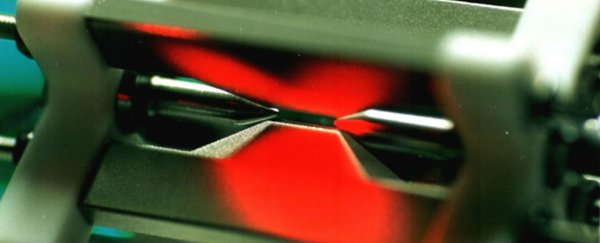For the first time, physicists have used a primitive quantum computer to simulate the spontaneous creation of particle-antiparticle pairs.
This marks the first full simulation of a high-energy physics experiment - something that our current computers are incapable of running - and could give physicists the opportunity to investigate how quarks bind together into protons and neutrons, and how these fundamental particles of the Universe form atomic nuclei.
Quantum computers are set to revolutionise computing in the future, because they're not limited to the 1s and 0s of binary code bits, used in the computers of today. Instead, quantum computers use qubits, which can essentially each take the state of 0, 1, or a 'superposition' of the two.
So rather than having bits that can only be 1 or 0 at any given moment, qubits can be anything and everything. This means they can perform many calculations simultaneously, giving them the potential for unprecedented processing power.
How unprecedented? Well, Google's D-Wave 2 'quantum computer' is 100 million times faster than your laptop, and many physicists argue that it's not even a proper quantum computer.
As Mary-Ann Russon reports for the International Business Times, back in 2014, an international team of computer scientists published a paper in Science showing that the D-Wave 2 failed certain benchmark tests, which means it was faster than regular computers in some tests, but actually slower in others.
The D-Wave 2 now works with twice as many qubits, but no one has been able to independently verify its quantum behaviour.
But there are tried-and-tested quantum computers out there - they're just really primitive. To simulate antimatter creation, a team of Austrian physicists used one that traps four calcium ions in a row with powerful electromagnetic fields, turning them into qubits floating in a vacuum.
When strategically placed laser pulses were fired at the qubits, the resulting quantum fluctuations in energy allowed the researchers to mathematically calculate if that energy had been converted into matter, creating electron particles and their antiparticles partners, positrons.
"They manipulated the ions' spins - their magnetic orientations - using laser beams," Davide Castelvecchi reports for Nature. "This coaxed the ions to perform logic operations, the basic steps in any computer calculation."
The team ran several sequences of 100 steps - each taking no more than a few milliseconds to complete, and then observed the state of the ions using a digital camera. They could tell by the location and the orientation of the ions if the process had created a particle or antiparticle in that spot.
The experiment was a pretty simple one, performed on a really primitive quantum computer, "but their calculations confirmed the predictions of a simplified version of quantum electrodynamics, the established theory of the electromagnetic force", says Castelvecchi.
If this could be scaled up, it would allow physicists to test the outcomes predicted in theoretical physics like never before.
"The stronger the field, the faster we can create particles and antiparticles," one of the team, Esteban Martinez from the University of Innsbruck, told Nature.
The only problem? Scaling quantum computers up is complicated as hell, and while Google's D-Wave 2 is now claimed to have over 1,000 qubits working inside, critics still can't agree on if its behaviour is truly quantum at all.
But with experiments like this, we're finally catching a glimpse of what science might be like with full-blown quantum computers in our corner, so hopefully that will give scientists the push they need to figure this one out.
The research has been published in Nature.
